Design Guidelines
The following guidelines set forth design principles intended to provide a framework for the design of future campus building and landscape initiatives, both new and restoration projects. The purpose of these guidelines is to encourage unity in design over time, while simultaneously allowing flexibility for positive innovation. The guidelines are a set of ideas intended to define a direction to positively influence those who design and manage the campus environment. The goal is to achieve an integrated campus design in which all of the campus parts relate to each other, regardless of when they were built.
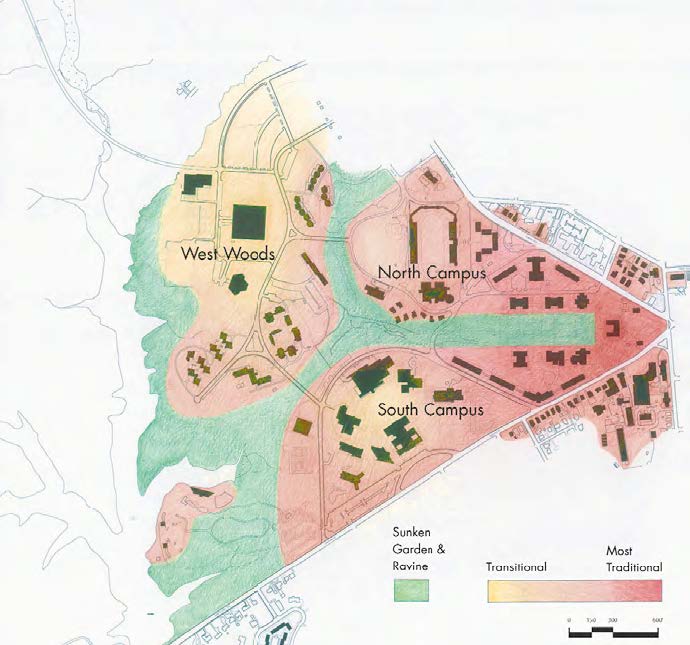
Architectural Design Guidelines
Four criteria should be considered in determining the appropriate architectural expression of each new building, addition or renovation on campus:
- Proximity to the Old Campus and/or Jamestown and RichmondRoads.
- Architectural characteristics of the existing neighboring buildings.
- Proposed use and scale of the new building.
- Hierarchical position within the campus plan.
The campus plan depicts this concept as a continuum of architectural design expression. This continuum is described in the following illustration, with the most intense shade of red denoting the most traditional design expression, orange reflective of less traditional forms and details, and areas shown in yellow suggesting designs of more transitional or interpretive expression.
Each future project should be designed within a continuum, with the Georgian architecture of the Old Campus representing the most traditional design expression. Geographically, this continuum originates at the Old Campus. Generally, the influence of the Old Campus on future design responses diminishes as the campus continues to develop to the west, so that projects in the West Woods will incorporate transitional or interpretative design ideas.
Likewise, the university desires to present an image of the campus to the public that is consistent with that of the Old Campus. Thus, projects along Jamestown Road should continue the traditional architectural character established by Barrett and Jefferson Halls. Those farther north, and thus closer to the modern buildings of the Library Quad, may be of more interpretive design. The West Woods may accommodate the most unique design responses.
This concept also suggests that programs that require non-traditional massing should be located away from the Old Campus and Jamestown Road . Examples of such programs include parking garages, athletic facilities, and large auditoria. If other considerations dictate that these buildings be located in areas visible from the Old Campus or Jamestown Road, design strategies to integrate buildings into their campus environment should be formulated.
New projects will be located and configured to create or enhance public spaces on campus as depicted in the Vision Plan. The specific spaces envisioned will be discussed in the Landscape Architectural section.
Design Guideline Vocabulary
The architectural design guidelines utilize two basic terms:
1. Architectural Order
Overall building qualities such as:
- Plan complexity and geometry
- Building scale
- Massing/typical bay spacing
- Extent to which proportions are governed by regulating lines
- Siting and orientation
- Symmetry/hierarchy of elevations
2. Architectural Elements
The design "detail" making up each building's exterior, including:
- Doors
- Windows
- Dormers, cupolas, and other roof features
- Cornices
- Roof detailing and materials
- Site details/brick style
With respect to architectural order and elements, the eighteenth- and nineteenth-century Georgian architectural forms found in the Old Campus represent the primary point of reference for the guidelines' discussion of architectural order and elements.
Design Guideline Implementation Terms
The guidelines suggest that project designers adhere to these standards in varying degrees, depending on the location of a particular project. The following terms reflect the extent to which the designer should follow the architectural design precedent exemplified by buildings found on the Old Campus:
Comply
Requires the project designer to utilize the same architectural language found on the Old Campus.
Interpret
Allows the project designer latitude to interpret the design precedents found on the Old Campus.
Unique
Permits the project designer to create architectural language in direct response to the subject building's immediate environment.
Design Guideline Implementation Strategy
Implementation of design proposals for future projects will be guided by the strategy illustrated in the table below:
| Most Traditional |
Less Traditional |
Traditional/ Transitional |
Transitional | Iconographic | |
| Architectural Order | Comply | Interpret | Interpret | Unique | Unique |
| Architectural Elements | Comply | Comply | Interpret | Interpret | Unique |
Most Traditional
It is intended that projects in areas identified as Most Traditional blend seamlessly with the Old Campus and the Sunken Garden Quadrangle. Buildings built, replaced, or renovated should be constructed and detailed in a manner consistent with the architecture of the eighteenth and nineteenth centuries.
- Architectural Order
Building footprints should be orthogonal and simple, typically either square, rectangular, or barbell shaped. Footprint area should not exceed 16,000 gross square feet.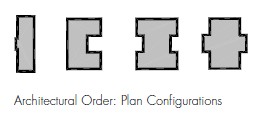
Roofs should be sloped, with a visible pitch of 45 degrees. Elevations should be symmetrical, follow classical proportions, and be organized into regular bays of a width consistent with buildings of the period. Buildings should maintain tripartite division of base, body and top/roof. Building siting should help establish campus edges or define public space.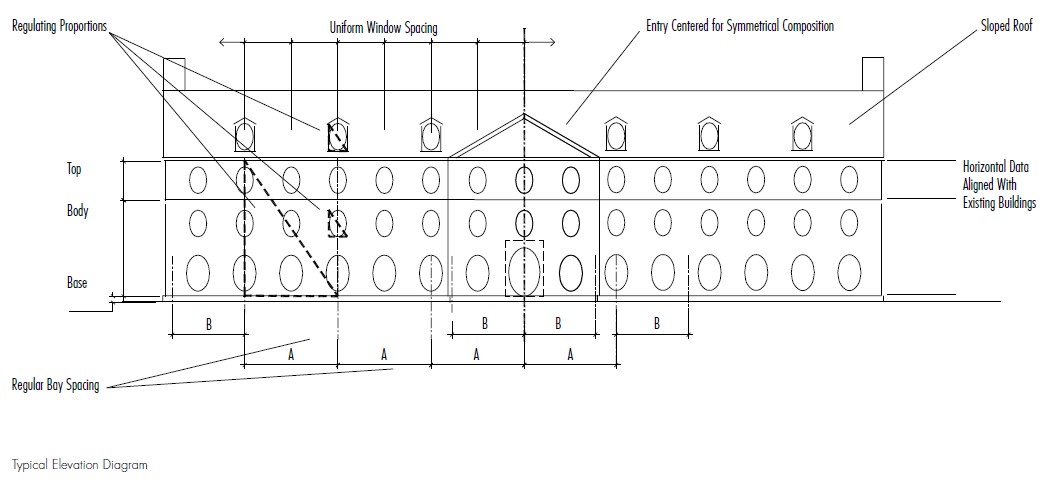
- Architectural Elements
Individual elements such as doorways, windows, dormers, cornices, and brick coursing should employ period details. Horizontal elements such as water tables, eaves, and ridges should be expressed and align with adjacent structures where possible.
These illustrations are representative of the architectural elements found on the Old Campus. References to the elements of the Old Campus should be interpreted in the context of these images.
Architectural Elements 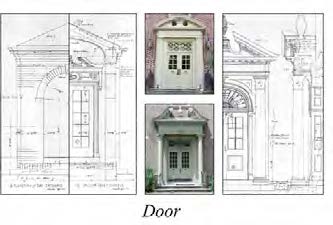
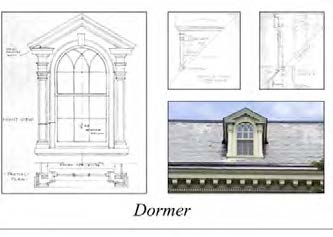
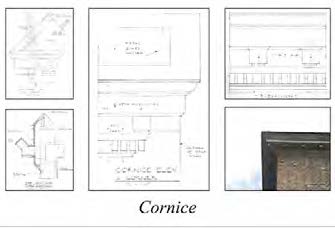
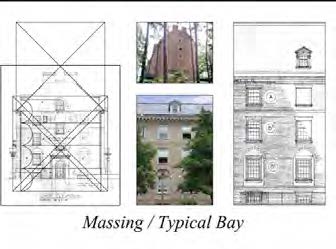
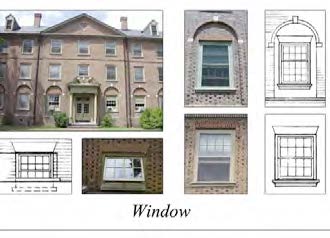
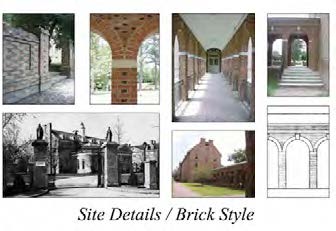
Less Traditional
Projects in Less Traditional areas may vary in the composition of their architectural order. However, the elements that comprise the design should continue to follow classical precedents, as in Traditional areas.
- Architectural Order
Building footprints should generally continue to be orthogonal, but may be more elaborate and larger than those found on buildings in the Old Campus.
Buildings should maintain tripartite division of base, body and top/roof. Adjacent to historic areas, this division should be literal; further away it may be more interpretive. Where appropriate, entries may be placed off center.
- Architectural Elements
Design details and selection of building materials should follow the precedents established on the Old Campus, although the composition of these elements may be more interpretive.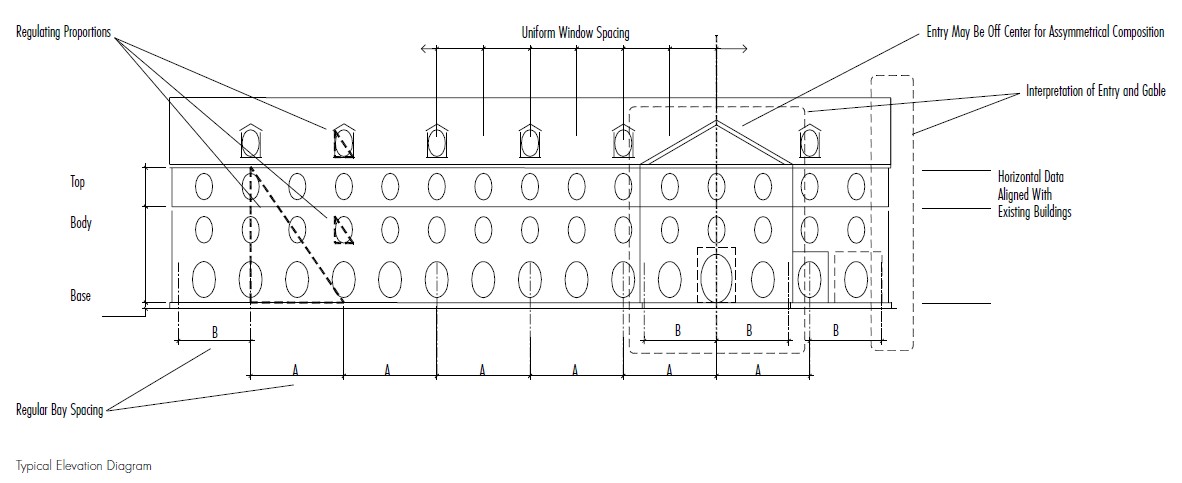
Traditional/Transitional
Buildings in Traditional/Transitional zones should establish an appropriate balance between the expression of traditional values and contemporary programmatic requirements. The projects may interpret both architectural order and elements.
- Architectural Order
Footprints may be non-orthogonal and larger than those found on the Old Campus.
The buildings of this category may have either a traditional sloped roof or flat roof, depending on their location and the design of existing structures in their vicinity.
- Architectural Elements
The elements on the elevations, though not necessarily designed in the style of the eighteenth and nineteenth centuries, should be consistent with traditional buildings in spacing, arrangement and scale. The diagrammatic elevation illustrates ways in which designs may achieve the desired balance.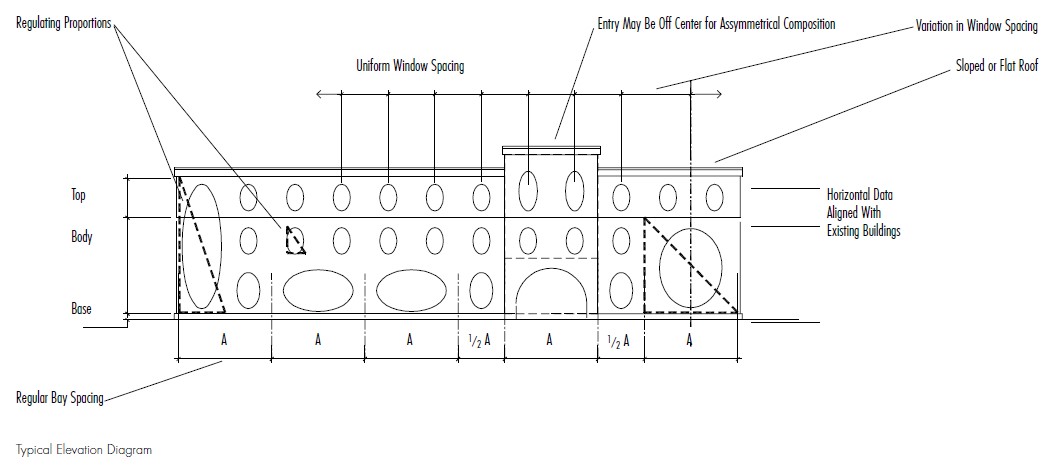
Transitional
Projects in Transitional areas will be afforded great latitude in their composition of architectural order. They are still encouraged to interpret the standards for architectural elements, and retain reference to the expressions of the past. W&M's University Center is an example of such a building. While the scale and massing of the building exceeds that of any historic structure, the exterior materials and roof configurations refer to the prevalent materials and profiles found on the Old Campus.
When additions are made to large-scale buildings within Transitional zones, certain components of the design may reference the Old Campus in a manner that improves the compatibility of the building with the rest of the campus.
- Architectural Order
Building footprints may be highly individual in their composition, and their scale may greatly exceed that of Old Campus buildings. Buildings in this zone may be sited as independent objects or building additions, but should contribute to the definition of public spaces as depicted in the Vision Plan.
- Architectural Elements
Design details and selection of building materials may interpret the precedents established on the Old Campus. While the details and materials may employ contemporary standards, they should, at the same time, retain a visual connection to these precedents.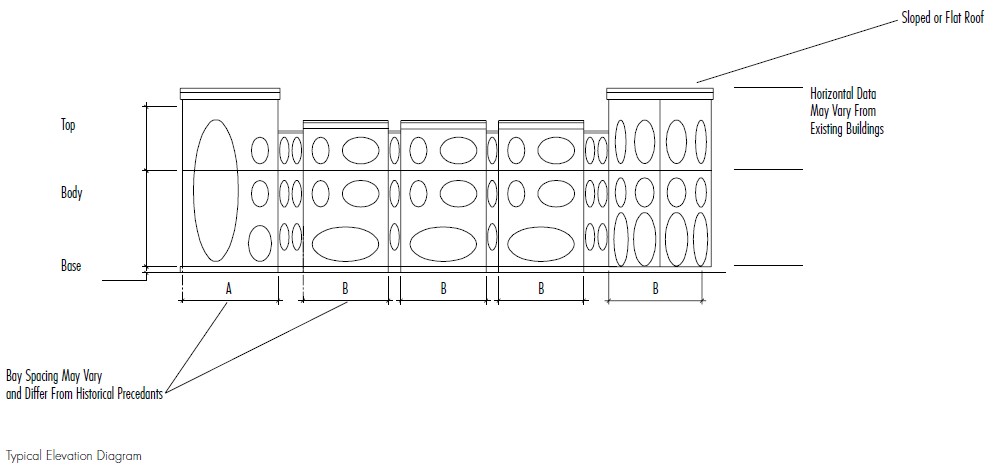
Campus Public Art and Iconographic Architecture
Campus public art and unique, iconographic architecture serve as a metaphor for intellectual inquiry, exploration and creativity. The contrast offered by the limited intervention of these elements also serves to amplify the importance of the historic and culturally traditional environment in which they reside. Buildings in this category should be small scale, sculpturally expressive structures that serve a civic or publicly symbolic function.
Public art can enhance the landscape and provide focus within public spaces. The grounds of the Kykuit estate in Pocantico Hills , New York are an example of the successful integration of art in the landscape. There are a limited number of specific locations on William & Mary Campus where it would be appropriate to site either a piece of public art or a special use building.
Potential locations for iconographic buildings or public art are identified on the campus plan.
Parking Garages
Parking garages, because of their large size and functional requirements, are frequently a challenge to incorporate into sensitive historic environments. Strategies for the design of parking garages at William & Mary include the following:
- Limit height to that of adjacent tree canopy.
- Build into topography when possible.
- Use facades to screen views of automobiles and sloped parking decks, placing level parking decks against exterior walls with sloped decks in the center of the structure.
- Surround the parking structure at the ground level with occupied space, either by setting back to allow a 60-foot building in front, or locating parking underground to allow building on top.
 Skip to main content
Skip to main content
